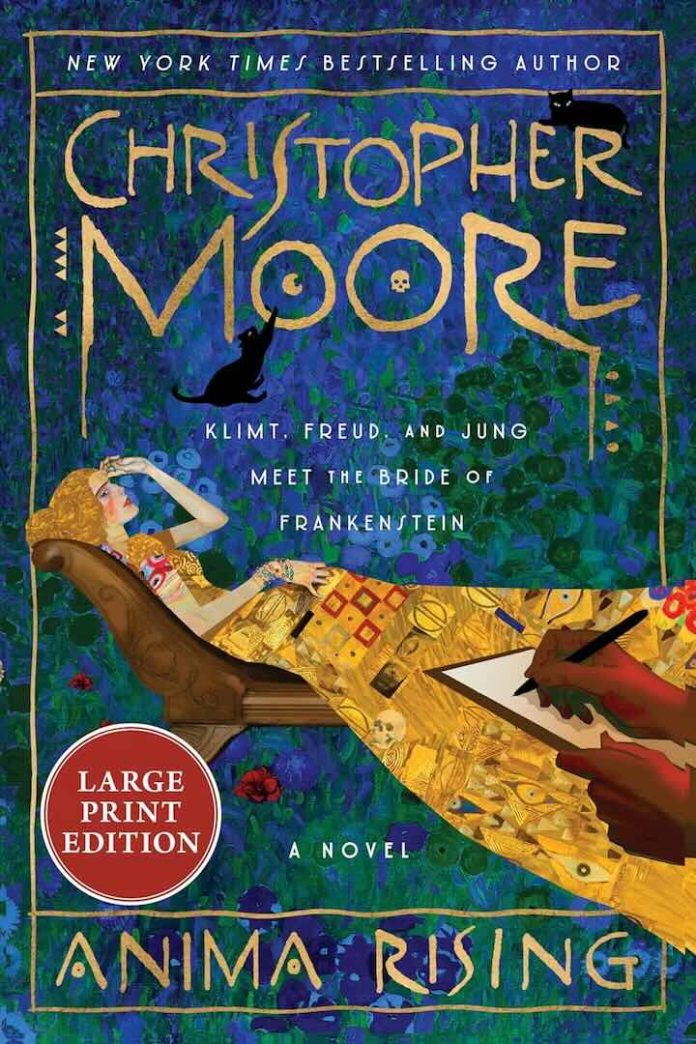Christopher Moore’s Anima Rising (2025) is a dazzling and macabre comedic fantasia that collides fin de siècle Vienna with gothic horror, Freudian psychoanalysis, and feminist retribution. Channeling the ribald irreverence that defines his earlier works like Lamb and Fool, Moore delivers a genre-bending tale of trauma, identity, and resurrection that is as unhinged as it is intellectually provocative. In this novel, Moore not only resurrects a literal Frankenstein’s bride, but also history itself—reimagined with wit, grit, and grotesque delight.
Setting the Stage: Vienna, 1911
Vienna at the dawn of the twentieth century was a city in the throes of intellectual, artistic, and political upheaval. Moore reanimates this world with his trademark absurdism, situating readers among figures like Gustav Klimt, Sigmund Freud, and Carl Jung, each rendered with outrageous charm and darkly comic insights. This is not a mere historical backdrop—it is a character in itself, buzzing with electric thought, erotic tension, and existential dread.
The story opens with Klimt discovering a nude, seemingly dead woman in the Danube canal. Instead of summoning the authorities, he sketches her. She wakes. Thus begins the journey of “Judith”—so named after Klimt’s own painting—an amnesiac woman who is anything but ordinary.
Plot Overview: What If Frankenstein’s Bride Survived?
As the narrative unfolds, Judith begins to piece together her origins. Her story, filtered through surreal hypnosis sessions with Freud and Jung, reveals she was created by Victor Frankenstein, abused by the patchwork creature Adam, and cast off into the Arctic ice. She dies, is reborn, dies again, and returns again—each time gaining more sentience, rage, and supernatural insight. She journeys through a mythic Underworld populated by Inuit deities like Sedna and Raven, absorbing their wisdom and power.
Eventually, she becomes an iconoclastic presence in Klimt’s Vienna—a muse, a menace, a myth—and is relentlessly pursued by enemies both literal and metaphorical, including a croissant-eating demon dog named Geoff, various henchmen, and her monstrous past.
Characters That Defy (and Define) Archetypes
Judith: The Reborn Feminine Fury
Judith is one of Moore’s most complex creations. Initially feral and memoryless, she becomes the novel’s intellectual and emotional core. She challenges the male gaze that created her—Klimt’s sensual art, Frankenstein’s grotesque science, and Adam’s domination—and reclaims autonomy through pain, wit, and transformation. Her journey is harrowing, filled with physical and emotional abuse, but Moore gives her sharp teeth and sharper comebacks. She is both victim and avenger, goddess and girl.
Gustav Klimt
Rendered with satirical affection, Klimt is a paradox—a hedonist with a moral compass, an artist obsessed with beauty yet fascinated by death. His relationship with Judith is one of mutual curiosity, bordering on co-dependence. Unlike Adam, he does not seek to possess her, but he is nonetheless complicit in her objectification.
Freud & Jung
Moore lampoons the gods of psychoanalysis with surgical precision. Freud is pompous, dismissive of women, and entirely uninterested in the mystical or spiritual. Jung, in contrast, is open to the numinous and becomes a compassionate listener to Judith’s layered tale. Their intellectual tug-of-war becomes a meta-commentary on the limits of psychology in explaining trauma.
“I was more focused on filling out my notes than on treating my patient.”
Themes: Electric Souls and Dead Gods
1. Resurrection and Reinvention
Judith’s literal rebirth from the dead mirrors her psychological resurrection. Moore uses the Frankenstein myth not to rehash Mary Shelley’s story but to ask: What happens when a woman created for another’s purpose finds her own?
2. Trauma, Memory, and Myth
Judith’s story operates on both literal and symbolic levels. Her past abuse at the hands of Adam—a soulless, patchwork brute—mirrors how patriarchal systems commodify and mutilate women. Her healing occurs not through psychoanalysis alone but through myth and communion with feminine archetypes like Sedna.
3. Art and Objectification
Through Klimt’s art and Vienna’s bohemian culture, Moore explores how women are muses, models, mistresses—but rarely narrators of their own story. Judith’s transition from Klimt’s model to the novel’s moral center upends this trope.
4. Humor as Survival
Despite the horror, Anima Rising is riotously funny. Moore deploys sarcasm, absurdity, and slapstick to offset the violence, making the novel accessible even as it navigates dark psychological terrain. Geoff, the croissant-eating demon dog, and penis-necklace jokes may not be for everyone, but they serve an important role in undercutting gothic melodrama.
Moore’s Prose: Literary Mischief and Wordplay
Moore’s writing in Anima Rising is saturated with intelligence, irreverence, and a deep love of language. He blends period authenticity with modern wit, creating a voice that feels timelessly anachronistic.
Readers familiar with Lamb, Fool, Sacré Bleu, or Noir will recognize Moore’s signature style—comic yet poignant, sharp yet sincere. His prose is lean where needed, lush where it counts, and punctuated with delightful absurdities.
He also demonstrates surprising restraint when the subject demands it. Judith’s recounting of her abuse is handled with care and nuance, never played for shock or humor. It’s this tonal balance that elevates the novel beyond parody or pulp.
Historical Intersections: Real Lives in a Fantastical Frame
Much like Sacré Bleu, Moore populates Anima Rising with real historical figures—Klimt, Freud, Jung, Egon Schiele, Alma Mahler—and reimagines their lives with mischievous liberty. However, he does his homework. From accurate references to Schiele’s rejection from the Vienna Academy (while Hitler was denied just a few lines down) to Alma Mahler’s turbulent love affairs, Moore treats his source material with unexpected reverence beneath the satire.
Highlights and Lowlights
Highlights
- A genre-blending triumph: Gothic horror meets historical satire meets feminist revenge fantasy
- Memorable characters: Judith is unforgettable, and even side characters (like the demon dog Geoff) are vividly drawn
- Historical depth: The blend of real and surreal events makes for a richly immersive world
- Humor with purpose: Laughs come not from ridicule, but from resistance, subversion, and survival
- Unflinching exploration of trauma: The horror elements are anchored in psychological realism
Lowlights
- Not for all tastes: Readers uncomfortable with explicit references to abuse, sex, or profanity may find some sections disturbing
- Genre whiplash: The narrative shifts between horror, absurdism, and historical fiction can feel jarring
- Density of references: Those unfamiliar with Freud, Jung, or early 20th-century Vienna might miss some deeper layers of satire
Comparative Reads and Literary Kin
If you enjoyed:
- Poor Things by Alasdair Gray – for the Frankenstein homage and feminist deconstruction
- Bride of Frankenstein (film) – for the undead bride reclaiming identity
- The Seven Husbands of Evelyn Hugo by Taylor Jenkins Reid – for the examination of women as muses and creators
- Circe by Madeline Miller – for the reclamation of a mythic woman’s voice
- Sacré Bleu by Moore – for more mythological historical fiction with irreverent wit
Then Anima Rising will likely charm and challenge you in equal measure.
Final Verdict: Electrifying and Unapologetically Bonkers
Christopher Moore’s Anima Rising is a triumphant resurrection of myth, horror, art, and satire. It is not an easy book—its humor is biting, its themes unflinching, and its protagonist wounded yet wild. But for readers willing to plunge into the icy depths of trauma and emerge electrified by feminist fury and comedic genius, Anima Rising offers a singularly strange and satisfying read.
It is Moore at his most deranged—and most brilliant.
About the Author
Christopher Moore is the bestselling author of 18 novels, including Lamb, Shakespeare for Squirrels, Noir, Fool, and Sacré Bleu. Known for his genre-defying narratives, Moore blends myth, literature, and pop culture into works of biting satire and human empathy.





